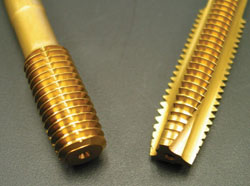This is a question that comes up quite often for machinists new to the industry, and even experienced machinists that don’t know a lot about tapping. While form taps and cut taps can both do the same job, which is making a threaded internal hole in a part, they are quite a bit different in how they work.
After using both kind of taps for a while, you’ll see the difference in looks right away. A cut tap doesn’t have a full thread until about the third time around, while a form tap looks the same from bottom to top. A cut tap also has clearance cut around the tool so that chips will move out of the way and not break it.
Cut Tap
Tapping with cut taps has been the most popular for decades because that’s what there was available. They are easy to use; just drill the hole with the correct tap drill size, making sure you go deep enough so that the tap will get enough threads, then run the tap into the hole. Depending on your machine’s capabilities and what material you’re running, you may only be able to run it at 200-300 RPM.
Rigid tapping is a very useful option on newer CNC Mills such as a Haas. It allows you to tap at higher RPM without putting so much load on your spindle. This equates to much faster tapping cycle times.
A cutting tap is great for thru-holes, as you won’t have to dig into the hole to pull out the chips. You also won’t have to worry about running into anything unless your table or fixture is under the hole.
Since this type of tap “cuts” threads into the hole, you can get away with using various coolants and mixtures without breaking tools, especially on soft materials like aluminum.
Form Tap

What’s better about form taps? Well, they have several advantages over cut taps that will make you want to use them more often. For one, they don’t make any chips. A form tap does just that, it “forms” the threads in the hole with pressure, as opposed to “cutting” threads.
That brings us to the next advantage; the threads are much stronger because they are “formed” into place. If you need strong threads in your parts, form taps are the way to go.
Form taps are stronger and will last longer than cut taps. This will save you time and money in the long run, as you won’t have as many taps breaking in your parts.
Not only will everything be stronger, but you can run at faster speeds, greatly reducing cycle times.
With all of these advantages, there’s gotta be some downfall, right?! Well, due to the higher pressure on the tool and part hole, it will require some better coolant or oil with high lubricity. If your coolant isn’t good enough, the tap will be have to work harder to form the threaded hole and eventually will break.
This is especially true on small form taps such as an M3 (Metric), as there just isn’t enough space for the average coolant to lube the tap. You need something with better lubricity that will reduce the load on the tool. Also, if your countersink isn’t big enough, the first thread will be pushed up above the material’s surface and will cause interference if it’s a mating part.
Other than that, there really isn’t much else to say about form taps. Sometimes you just have to experiment until you find out what works the best. If your tap keeps breaking, change it up with different speeds, coolant, or a different tap.
